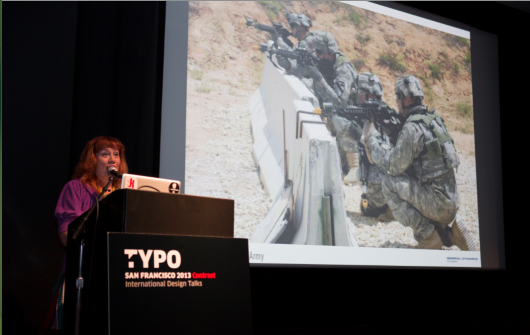Tonia always considers the cultural context (including region, age, education, and organizational backgrounds) when she creates UX design. She also pays close attention to the language she employs in design. For example, the difference between the option to “clear data” or “purge data” implies different levels of finality in the selection.
Similarly, our innate color associations intuitively convey information, as the color green signifies a positive connotation, yellow implies caution, red is a indicator to stop and grays are generally neutral. In Tonia’s work designing UX for the defense community, the color blue applies to friendly individuals while red is a hostile individual.Placement of information and windows will impact your UX. It’s important to consider primary, secondary and tertiary goals of your user when designing the placement of windows, and if information is easily hidden or if chats are needed to maintain the workflow.
Josh Damon Williams (@joshdamon) was a Director at Hot Studio’s and brings a background in film studies to UX design. His experiences in film intuitively lead him to consider the flow of information he waned to convey to users and this naturally lead to creating information architecture.
Although Josh came to UX design through film school, his been an extremely successful designer and is an example that not everyone comes to design through design school. In fact, diverse teams with varied backgrounds tend to make for better teams.
Josh recommends thinking through the story you want your information to tell, which will make you a stronger designer. Not only is your design better tailored to your audience, it allows you to communicate your designs better to teams and clients.

Tonia Bartz

Josh Damon Williams

Toke Nygaard
To facilitate your story, Josh highly recommends using storyboards to outline your information and overall he says, “Storyboards are awesome.” In film, storyboarding focuses on an event – the key movement or action you want to convey, the camera cut/fade or dissolve, a camera move and to make your point. You can apply this framework to your UX design. The book “See What I’m Talking About” is a book that exemplifies the concept of using storyboards and comics to convey a message.
Toke Nygaard (@tokenygaard) is the Chief Creative Officer at Zendesk, a customer service software with many of the big name social media companies as clients. Fresh out of design school, an experience he called “extremely crap,” Toke was a founding partner of one of the largest pioneering design communities, K10k. Toke was also co-founder at Cuban Council, a boutique design agency founded in the ruble of the dot com crash that focused on “doing good work” for select clients.
Toke left Cuban Council to become chief creative officer at Zendesk. This experience allowed him to answer the question, “Should I quit my agency to work for a start up or on the product side?”
According to Toke, the differences between working for an agency and the product side can be summed up in different work cycles, focus, coherence, end product and, importantly, hair.
Agency work has short cycles with an emphasis on “getting shit done,” while working on the product side allows for a much slower experience. Agencies have a broad focus and range of clients while working on the product side allow for one focus. Likewise, agency work tends to be directed and there’s not much coherence with the bigger company or mission while working the product side has a lot of coherence. There is no control over the use of the end product with agency work, but with a product, you have a “flotilla” of support.
And, in the all-important question of who rocks the better hair, the clear winner (according to Toke) is in the agency employees.























